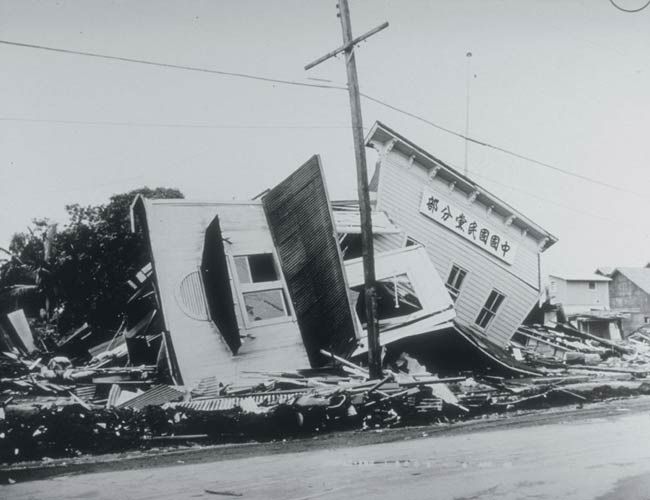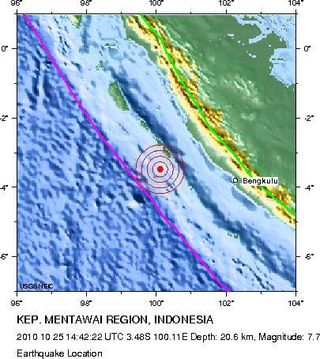
Sneaky 'Slow' Earthquakes Can Cause Outsize Tsunamis


The Tohoku earthquake that caused the devastating tsunami in Japan was massive — the 9.0-magnitude quake is the fourth-largest ever measured. As far away as Tokyo, some 230 miles (370 kilometers) from the rupture zone along the seafloor, skyscrapers swayed and shook like small trees in a wind.
For those closer to the earthquake itself, within about 80 miles (130 kilometers) of Japan's northeastern coastline, the shaking was a sign that a tsunami was imminent.
For thousands, the water came too quickly for escape.
However, not all tsunamis are born of sudden, violent earthquakes. In fact, some relatively low-magnitude earthquakes are capable of causing enormous — and often deadly — tsunamis. [Related: In Pictures - The Japan Earthquake and Tsunami.]
Slow quakes
It turns out this special class of earthquakes, capable of causing such outsize waves despite their lower magnitude, rupture more slowly than regular earthquakes.
Earthquakes usually rupture at about 1.8 miles (3 km) per second, about 10 times the speed of sound, said Andrew Newman, an assistant professor at Georgia Tech's School of Earth and Atmospheric Sciences.
Sign up for the Live Science daily newsletter now
Get the world’s most fascinating discoveries delivered straight to your inbox.
In contrast, these "slow" earthquakes "rupture anywhere between 1 to 1.5 kilometers [0.6 to 1 miles] per second, so that's one-third to one-half the speed," Newman said.
To understand what an earthquake's speed means, Newman said, it's important to understand that earthquakes happen in lines, with a starting point and an end point. The epicenter is just where the rupture begins.
In slow earthquakes, the movement can travel just a few miles — or hundreds of miles, just as a normal earthquake does — but the speed with which the rupture streaks along the fault line is lower.
Differentiating — in real time — between these slow earthquakes and more typical, faster earthquakes can be a tricky business, and can mean the associated tsunami risk is underestimated, Newman said.
"These earthquakes are very troublesome, because people don't feel them very strongly so they don't prepare for the tsunami," said Hiroo Kanamori, a professor emeritus of geophysics at Caltech.
Tsunami mystery
Kanamori, who was the first to identify these "slow" earthquakes, began his research in the area as a young scientist in the early 1970s, inspired by a strange historical event.
In 1896, the Sanriku earthquake, which occurred along the same intersection of continental plates that ruptured in the most recent earthquake in Japan, created a tsunami of astonishing might — one that took many by surprise.
Waves as high as 124 feet (38 meters) swept ashore, killing as many as 27,000 people and injuring as many as 9,000 However, Kanamori told OurAmazingPlanet, contemporary accounts of the earthquake describe only a gradual, slow shaking, so there was no concerted effort to flee.
"I was curious about it why it was so slow," Kanamori said.
Data revealed the earthquake was a 7.2 magnitude, a surprisingly small number for such a huge tsunami.
In contrast, the highest waves of the most recent tsunami were, on average, around 24 feet (7 meters) high, with one eyewitness reporting a wave 42 feet (13 meters) high.
Through further research, Kanamori identified this new class of "slow" earthquakes, which he began to call "tsunami earthquakes" — a brand of quake that, although rare, can be particularly dangerous because of the sneak-attack tsunamis they produce.
"In the last 20 years, one-third of the earthquakes that generated tsunamis that caused significant casualties were these slow earthquakes," Newman said.
Shallow vs. deep
So why do these "slow" earthquakes create such powerful tsunamis?
One answer lies in where the earthquake itself happens along the subduction zone — an intersection of the Earth's plates where one plate is shoved below another one.
"Along a subduction zone, usually the deeper parts slip very rapidly and very shallow parts slip relatively slowly," said Kanamori. So these slow earthquakes rattle an area far closer to the seafloor than the deeper, faster quakes.
Newman has developed a program that assesses the energy produced in earthquakes. He said the program, called RTerg, is particularly good at identifying these rare "slow" earthquakes, and in real-time.
The program uses the same seismic data available to current tsunami modeling centers, but looks at it in a new way, and the National Oceanic and Atmospheric Administration is running the program in test mode at its Pacific Tsunami Warning Center in Hawaii.
Newman emphasized that RTerg is still being tested and refined, but said he hopes it can eventually be incorporated into tsunami warning systems around the globe.
"Tsunami warning centers can already identify the approximate magnitude of an earthquake," Newman said.
RTerg's value is in its ability to identify an earthquake as a slow earthquake, one with the potential to create a much more dangerous tsunami than initial warnings might suggest, Newman said, allowing authorities to alert coastal populations that the situation is urgent.
"You'd react differently if you heard there was a chance of light sprinkles versus if there was a once-in-a-hundred-years storm," Newman said.
This article was provided by OurAmazingPlanet, a sister site to LiveScience.











